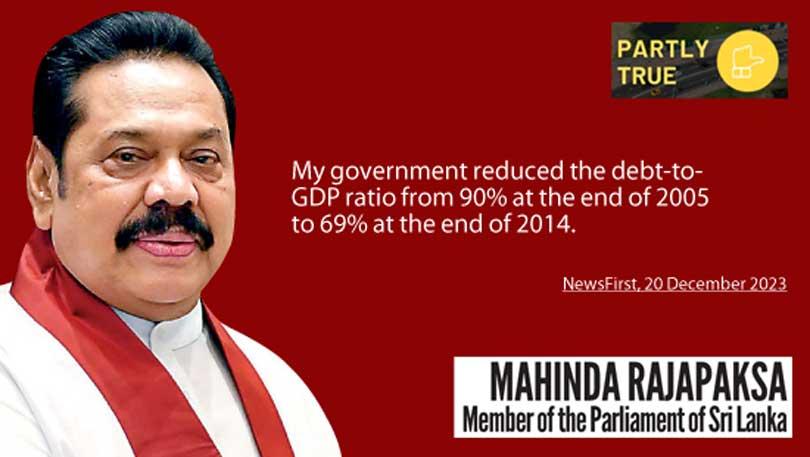01 Feb 2024 - {{hitsCtrl.values.hits}}

 In his statement, the MP claims that Sri Lanka’s debt-to-GDP ratio reduced from 90% at the end of 2005 to 69% by the end of 2014.
In his statement, the MP claims that Sri Lanka’s debt-to-GDP ratio reduced from 90% at the end of 2005 to 69% by the end of 2014.
To check this claim, FactCheck.lk referred to the Annual Reports of the Central Bank of Sri Lanka (CBSL) and the Ministry of Finance.
The accounting of national debt involves (1) Central Government Debt (CD), which is limited to debt held by the government Treasury, and (2) Public Debt (PD), which, in addition to CD, includes the debt in the books of State-Owned Enterprises (SOEs). Globally, including by the IMF, the debt burden of a country is evaluated based on PD, not CD only, because it is PD that gives a fuller accounting of a nation’s debt obligations.
The PD-to-GDP ratio at the end of 2005 was 92.1% and was 76.5% at the end of 2014. This does not align with the MP’s figures. However, his figures align with the CD-to-GDP figures of 90.8% and 69.5% in 2005 and 2014, respectively.
By citing only the part of the debt that is accounted for as CD, the MP (a) misrepresents the overall debt exposure in 2014, and (b) suggests a larger reduction in debt-to-GDP ratio (of 21.3 percentage points) from 2005 than the actual decrease of 15.6 percentage points in terms of PD.
The MP’s use of CD figures is further misleading because former President Mahinda Rajapaksa’s administration was found to manipulate and understate CD by transferring debt that was originally in the books of the central government into the books of SOEs. This accounting manoeuvre artificially reduced the reported CD without making any reduction in PD. For instance, in 2014, the loan balances for the Puttalam Coal Power Plant, Hambantota Port Development, and Mattala Rajapaksa International Airport, amounting to LKR 309 billion (or 3 % of the GDP in 2014), were removed from the books of CD and moved to the books of various SOEs (see Additional Note).
The MP’s figures on debt-to-GDP reduction are not only citing a partial accounting of total debt by using CD figures instead of PD figures, but he is also citing a CD figure that was manipulated during his presidency to report a lower figure in 2014. The actual reduction of debt-to-GDP in that time period was significantly less (less than three-fourths in percentage points) than what the MP had claimed. However, the reduction in PD-to-GDP by 15.6 percentage points does support perhaps the larger claim of the MP that there was a substantial reduction in debt-to-GDP during that period.
Therefore, we classify the MP’s statement as PARTLY TRUE.
Additional Note: For more details on this manipulation of debt reporting refer to Verité Research, ‘Navigating Sri Lanka’s Debt: Better reporting can help – a case study on China debt’, 2021, p.5.
*FactCheck.lk’s verdict is based on the most recent information that is publicly accessible. As with every fact check, if new information becomes available, FactCheck.lk will revisit the assessment.
FactCheck is a platform run by Verité Research.
For comments, suggestions and feedback, please visit www.factcheck.lk.
27 Apr 2024 27 Apr 2024
27 Apr 2024 27 Apr 2024
27 Apr 2024 27 Apr 2024
27 Apr 2024 27 Apr 2024
27 Apr 2024 27 Apr 2024